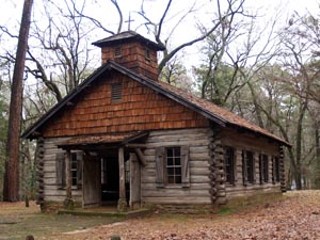Day Trips
A replica of Mission San Francisco de los Tejas is the centerpiece of the Mission Tejas State Park north of Crockett
By Gerald E. McLeod, Fri., Jan. 26, 2007

Mission San Francisco de los Tejas attempted to bring religion in the 1700s to an East Texas Native American culture that already had an ancient spiritual tradition. The well-meaning padres increased their chances of failure to colonize the Indians by also trying to teach agriculture to a civilization that had farmed the rich soil for centuries.
A replica of the Spanish mission is the centerpiece of the Mission Tejas State Park north of Crockett. The Civilian Conservation Corps built the log chapel near where a cannon barrel was found in 1928. Departing friars burned the original mission in 1693 after using it for a little more than two years.
Archeologists believe that wandering bands of hunters and gatherers gradually settled along the Grand Bend of Red River near the junction of present-day Texas, Arkansas, and Louisiana. From there the confederation of the Caddo Nation spread south. The Caddo comprised three main groups: the Natchitoches in Louisiana, Hasinai in Texas, and the Cadohadachos between the two. Each group included several smaller tribes. Tejas was the Caddo word for members of allied tribes or friends.
The native people in the northeast corner of Texas had a thriving culture by the time La Salle arrived from France followed by Alonso de León carrying the Spanish flag in 1689. Unlike the natives on the plains and the coast, the Hasinai greeted the European adventurers cordially and as equals.
European visitors found an advanced people living in villages of tall, cone-shaped thatch huts surrounded by fields of maize, beans, tobacco, and squash. The eight tribes that made up the Hasinai of East Texas were expert hunters and traders who covered a wide area of the central United States. Their pottery was some of the most ornate of American Indians during the period.
When the Spanish arrived in 1690 to establish four missions, the 4,000 to 5,000 native residents lived around present-day Nacogdoches. They had already learned that the French in Louisiana were valuable trading partners; exchanging hides for guns and metal tools. The Spanish missionaries came to create new citizens loyal to the king and to halt France's western migration.
Mission Tejas near the Neches River was the first of the missions to be established. The Indians were slow coming to the mission even though the Spanish had a Hasinai woman, for whom the Angelina River was most likely named, to interpret for them.
The mission was the beginning of the end for the once-influential Caddo tribe. In the first year of the missions in East Texas, a smallpox epidemic raged through the area. Having no immunity to European diseases, nearly 3,000 Hasinai died, including 300 at Mission Tejas.
By 1773, the Spanish retreated south, and the mission was re-established in San Antonio as San Francisco de la Espada Mission. A new threat to the Caddo was moving in from the east. Native peoples were being pushed west by the expansion of the American colonies. At first the Caddo accepted the new arrivals as brothers, but fights erupted over dwindling hunting grounds. Finally, while the French came for trade with the Indians and the Spanish came to save their souls, the Americans came for their land. By 1859, fewer than a thousand members of the Caddo Nation survived and were relocated to a reservation in western Oklahoma outside of Binger.
Mission Tejas State Park covers 363 acres off of TX 21 outside of Weches, 22 miles north of Crockett. Constructed on Texas Forest Service land in 1935, it became a state park in 1957. The park has 15 campsites under the towering pine trees planted by the CCC, plus several miles of hiking trails and the Rice Family Log Home, one of the oldest surviving buildings in Houston County. The staff provides excellent educational programs on weekends throughout the year, and don't forget to take a peek at the baby rattler at the park headquarters. For information, call 936/687-2394, or go to www.tpwd.state.tx.us. For campsite reservations, call 389-8900.
You can see ancient Caddo burial grounds a few miles north of Mission Tejas at Caddo Mounds State Historical Park. The park opens Wednesday through Sunday, 8am to 5pm.
813th in a series. Day Trips, Vol. 2, a book of Day Trips 101-200, is available for $8.95, plus $3.05 for shipping, handling, and tax. Mail to: Day Trips, PO Box 33284, South Austin, TX 78704.








